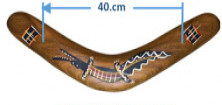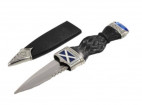Culturally or religiously significant items have a higher personal value to you.
These include items for:
Some passengers would like to take culturally significant items into the cabin of the aircraft with them. This is not always possible, as some items are restricted from entering the cabin of aircraft due to security concerns.
The Aviation Security Service is required to prevent passengers from taking items capable of causing serious injury on board an aircraft. This includes firearms, disabling weapons and explosives, but also includes:
The following are examples of culturally significant items carried by passengers, and when it is okay to go as carry-on or when they must go as checked luggage.
If the item you are taking, is not listed below, but has similar characteristics to an item that cannot go as carry-on, please pack in your checked luggage
Other countries may have less or more strict rules around these items, so you should always check with your airline if you are flying internationally.
If you take an item with you as carry-on when it should have been packed in your checked luggage, there could be serious consequences for you, including:
| Carry-on bag | Checked-in luggage | |
| Within 40cm restriction | ||
 |
||
| Exceeds 40cm restriction | ||
 |
Boomerangs are traditional hunting weapons used by indigenous Australians.
There are two types of boomerang:
Returning – they have two equal arms connected at an angle
Hunting – they have two arms with one significantly longer than the other.
They are common souvenir items.
Boomerangs that are more than 40cm in length, measured from tip to tip, must go in checked luggage.
If the boomerang is less than 40cm, it is okay to take as carry-on luggage.
| Carry-on bag | Checked-in luggage | |
| Within 40cm restriction | ||
 |
||
| Exceeds 40cm restriction | ||
 |
Didgeridoos are traditional musical instruments of indigenous Australians. They are made from hollowed hardwoods and can range in length from under half a metre, to over three metres in length.
They are common souvenir items.
Didgeridoos that are more than 40cm in length, measured from tip to tip, must go in checked luggage.
If the didgeridoo is less than 40cm, it is okay to take as carry-on luggage.
| Carry-on bag | Checked-in luggage |
Heru is a traditional Māori ornamental comb usually carved from a solid piece of wood or bone used to fasten long hair on top of the head.
There are no restrictions applying to the heru. You can wear it or carry it in either, your checked or carry-on luggage.
| Carry-on bag | Checked-in luggage |
Hoe is a traditional Māori waka (canoe) paddle. In addition to be used to row, the hoe was also used as a weapon.
Hoe (waka paddle) that are more than 20cm in length, are restricted from carry-on luggage but they can go in your checked-in luggage.
| Carry-on bag | Checked-in luggage |
Mere is a short flat-bladed weapon in the shape of a large teardrop, commonly made from pounamu.
Patu have a similar shape to Mere but are made from stone or wood.
Wahaika are short club usually carved from a solid piece of bone, wood or stone. These items are commonly purchased as souvenir items.
All traditional Māori weapons (including souvenirs) that are more than 20cm in length, measured from end to end, are restricted from carry-on luggage, but they can go in your checked-in luggage.
| Carry-on bag | Checked-in luggage | |
| Within 20cm restriction | ||
| Exceeds 20cm restriction |
Purerehua (bullroarer) is a musical wind instrument consisting of a single piece of bone, wood or stone in the shape of a blade-like object attached to a cord, that is twirled vigorously in the air.
Its shape and the materials it is made of, make it an effective weapon. Any purerehua more than 20cm in length, are restricted from carry-on luggage, but they can go in your checked-in luggage
| Carry-on bag | Checked-in luggage |
Putorino (bugle flute) is a musical wind instrument made from split and hollowed hardwood. The putorino is usually between 20cm and 50cm in length.
There are no restrictions applying to the putorino. You can carry it in either your checked or carry-on luggage
| Carry-on bag | Checked-in luggage |
Taiaha is a close quarter weapon used for short strikes or stabbing thrusts. Taiaha are usually between 1.5 and 1.8 metres in length.
Taiaha are a common souvenir.
Taiaha cannot go as carry-on but it is okay for it to go in your checked luggage.
| Carry-on bag | Checked-in luggage |
Tokotoko is a traditional Māori carved ceremonial walking stick. On a marae, it is a symbol of authority and status for the speaker holding it.
Tokotoko, like Tiripou (walking sticks), are allowed in carry-on if used as a mobility aid to assist you moving around, otherwise they are to go as checked luggage.
| Carry-on bag | Checked-in luggage | |
| As a pendant | ||
| If attached to a handle |
Toki (adze) is a traditional Māori tool used to carve canoes and detailing on meeting houses. The adze head can be made of pounamu and worn around the neck.
Toki are a common souvenir
Toki as a pendant is okay to be worn or taken as carry-on, but if attached to a handle, it must be carried in checked luggage.
| Carry-on bag | Checked-in luggage | |
 |
Dirk is a traditional Scottish dagger approximately 30cm in length worn around the waist. A dirk is sometimes confused with a Sgian Dubh, which is significantly smaller and placed in the sock when a kilt is worn.
Both Dirks and Sgian Dubh are restricted to checked luggage. While the Sgian Dubh blade may be less than 6cm in length as each side of the blade mirrors the other, there is a risk it will be removed as an offensive weapon.
| Carry-on bag | Checked-in luggage |
Kirpan is a small curved dagger. To Sikhs, the kirpan is a blessing from the Guru and holds very high spiritual significance.
If the Kirpan’s blade is less than 6cm it can go as carry-on, otherwise it will need to go in checked luggage. Not all countries allow blades of any type on board an aircraft. If you are carrying a Kirpan of any length and transiting an overseas airport to and from New Zealand, you may need to speak to your airline representative.
We understand some passengers may experience distress when items with significant religious meaning to a passenger are handled by Aviation Security officers (officer) during security screening.
Religious items are not exempt from security screening, here in New Zealand or elsewhere. This is because such an exemption would create a point of vulnerability that could be exploited by persons intending harm. Any such exemption would substantially reduce the effectiveness of security screening as persons intending harm could exploit the exemption by having persons carry religious items that contained prohibited items.
While there is no exemption, there are steps passengers can take to reduce their religious items from being physically inspected, including:
These steps will not guarantee that your religious items won’t be subject to further search, but they should reduce the likelihood of that happening.
If x-ray image requires the religious items to be physically inspected you will be asked to consent to a search before the religious items are physically inspected. During the search the officer will be wearing gloves. If you do not consent to the search or withdraw consent for the search you will not be permitted to pass security screening. If this happens you will need to speak with your airline as you could miss your flight.
Please ask our officers any questions you have on the security process that applies to religious items. If you have concerns, you can request to speak to a Duty Supervisor.
If you have concerns that your property could be damaged, here are four packing tips that will help protect it:
If the item cannot fit in the overhead storage, the item will need to go as checked luggage. If you are concerned that the item could be damaged during carriage by air, you must consult with your airline to discuss appropriate carriage. There is a risk that the airline may refuse carriage of valuable items if you have not advised them before you travel.
If you have any questions about this topic, use our contact form, or email reception@avsec.govt.nz.